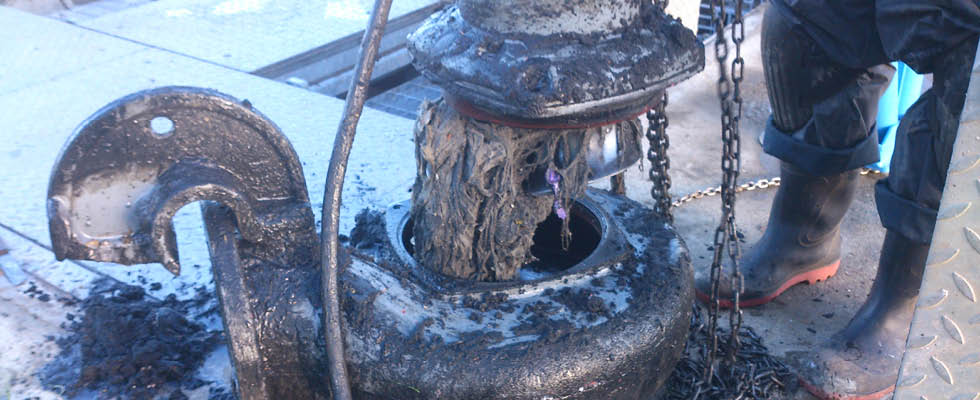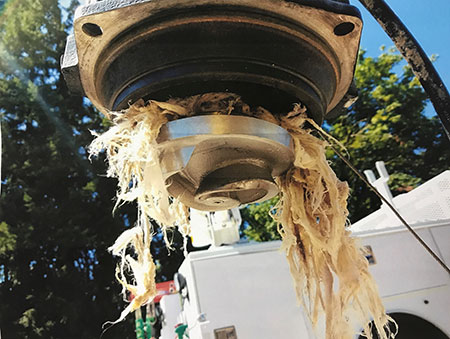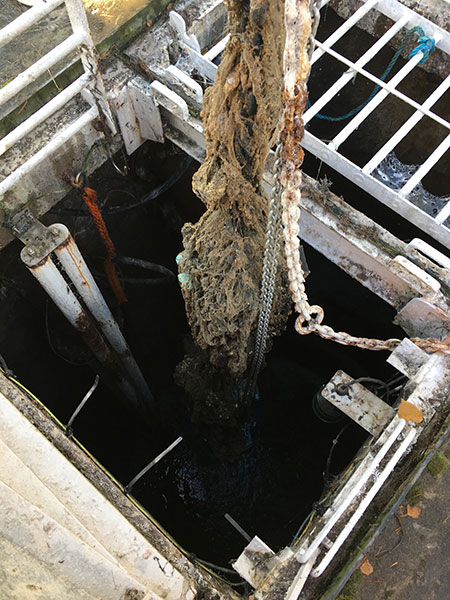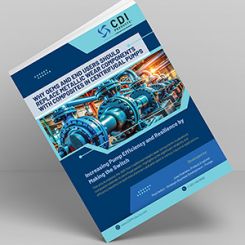
Traditional condition monitoring for motors typically centers around vibration analysis. However, when it comes to submersible wastewater pumps, this approach presents challenges due to the harsh and complex nature of the environment.
Submersible pumps operate underwater, making the installation of external sensors difficult. Cabling becomes cumbersome, and the management of additional wires—especially during pump removal—can lead to snagging issues or even electrical interference when routed alongside power cables. Wireless sensors are not viable either, as they lose signal once submerged. Furthermore, the constantly changing nature of wastewater—driven by modern water-saving devices and increased nonbiodegradable solids like wet wipes—creates a variable load on the pump that traditional monitoring tools struggle to interpret reliably.

Solids content in wastewater is increasing due to low-flow plumbing, waterless urinals and the widespread use of wet wipes. These materials make pumping less efficient and complicate efforts to identify genuine mechanical issues. Without real-time, accurate insights, operators often must rely on reactive maintenance after a failure occurs.
While some sites attempt vibration monitoring via cabled sensors, these systems typically feed data into supervisory control and data acquisition (SCADA) platforms with limited resolution and minimal signal processing capabilities. Alarms are often triggered using simple threshold set points, lacking the nuance to distinguish between transient events and real faults.
For example, debris such as stones passing through the volute can create momentary vibration spikes that falsely trigger alarms. These false positives lead to unnecessary callouts, frustrating maintenance teams and eroding confidence in the monitoring system. Even when signal processing exists, persistent vibration from accumulated rags or wet wipes may still cause alarms. Technicians then visit the site, pull the pump and find a clogged impeller—not a mechanical failure. Because the pump continues to function (albeit inefficiently), this is seen more as a nuisance than a critical issue, encouraging a “wait until it trips” mindset.
Traditional monitoring methods are often hampered by SCADA limitations, physical installation challenges and a lack of tolerance for nuisance alarms.

Dynamic Torque Monitoring
An alternative to traditional methods is dynamic torque monitoring, which provides real-time insight into pump health without the need for additional sensors on the pump body. Instead of measuring vibration, this method analyzes the motor’s power draw dynamically, tracking how electrical power is consumed and converted into mechanical torque.
Because the sensing equipment is installed in the control panel rather than in the field, this approach can reduce installation complexity, eliminate interference concerns and avoid introducing additional cables into the well that can snag or wear.
Dynamic torque monitoring captures exactly what is happening within the pump. It works by continuously measuring power consumption across a dynamic time window, allowing both short-term anomalies and long-term trends to be identified. To avoid false alarms caused by normal process variability, several factors must be accounted for:
- High-speed sampling is critical to detect brief power anomalies—like a rock hitting the impeller—and differentiate them from sustained issues. These transient events can be logged without triggering alarms.
- Long-term trend analysis enables early detection of mechanical degradation. A slow decrease in power draw over weeks or months might indicate impeller wear, whereas a gradual increase could suggest bearing degradation.
- Three-phase current imbalance can reveal asymmetrical loading, often a precursor to motor failure. Tracking this over time provides valuable predictive insights.
- Runtime monitoring based on power use helps assess overall system efficiency and health.
While power data collection itself is straightforward, the key lies in interpreting the data correctly and maintaining data integrity. Operational changes—such as variable frequency drive (VFD) speed adjustments, changing well levels or multiple pumps sharing a discharge line—can affect power consumption. These variables must be accounted for in the monitoring system to ensure accurate differentiation between expected performance shifts and actual equipment faults.

Addressing Wet Wipes & Rags
Wet wipes and rags are particularly troublesome. They tend to accumulate on the impeller slowly, degrading performance and potentially triggering false alarms. Dynamic torque monitoring offers a solution here as well: By identifying the characteristic power signature of rag buildup, the system can initiate an automated deragging cycle (typically a controlled pump reversal) to clear the blockage.
This not only helps maintain efficiency but also ensures cleaner data by eliminating the noise caused by partial obstructions. Importantly, dynamic torque monitoring can differentiate between the symptoms of rag buildup and mechanical wear, allowing deragging to occur only when appropriate and minimizing unnecessary alarms.
Dynamic torque monitoring presents an alternative to traditional vibration-based condition monitoring systems, especially for submersible wastewater pumps. It sidesteps the physical installation barriers, avoids the pitfalls of nuisance alarms and offers a more actionable set of insights—captured directly from the pump’s power usage.
By monitoring key performance indicators across appropriate time frames, utilities and wastewater operators can transition from reactive to predictive maintenance, extending asset life, reducing downtime and optimizing operational efficiency.
For more on condition monitoring, visit pumpsandsystems.com/tags/condition-monitoring.

